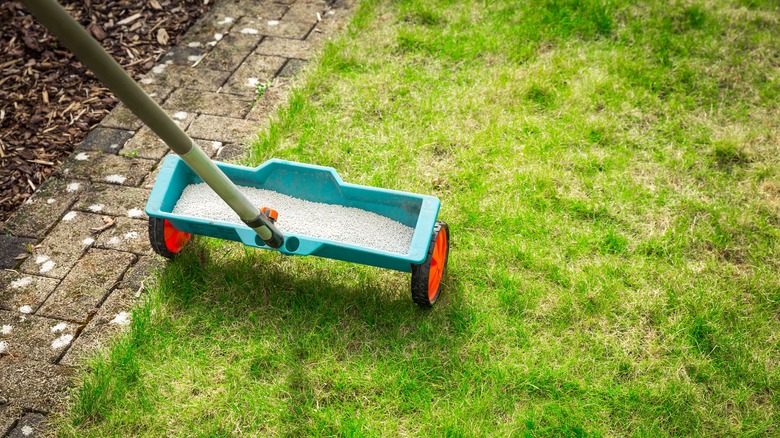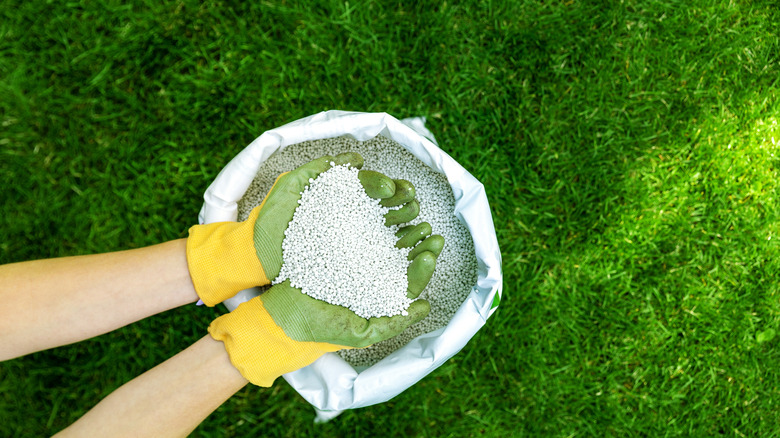How To Decide Which Fertilizer Is Best For Your Lawn
If your grass is looking patchy, brown, or simply worse for wear, you might be tempted to head to the garden center and buy the first bag of fertilizer you see. You don't need to have a green thumb to know that fertilizer helps ailing plants, so an infusion of some basic nutrients might be just what you need to have a lush green lawn that's easy to care for. But it's not quite that simple.
"When it comes to choosing the right fertilizer for your lawn, it's not just a grab-and-go from your local garden store," Bryan Clayton, CEO of GreenPal and lawn expert with over 20 years of experience, exclusively tells House Digest. "You've got to be a bit more strategic about it to get your turf looking its best." That means understanding all the different factors of what harms and boosts grass.
This includes knowing that different types of grass require different fertilizer formulas, and that those formulas change with the weather or season. Basically, there is no one-size-fits-all when it comes to fertilizer, especially if you want to use it to establish a healthy lawn for years to come. "Choosing the right fertilizer isn't just about making your lawn green for a season; it's about setting up a healthy, resilient turf that can stand the test of time and weather," Clayton explains. Here is a closer look at how to choose the right fertilizer for your particular grass.
Different types of grasses require different types of fertilizers
The first thing you need to do when narrowing down what kind of fertilizer to get is to identify what type of grass you have. "Different types of grasses have different needs," Clayton tells House Digest. "For instance, if you've got a cool-season grass like fescue, you're going to use a different type of fertilizer than you would for warm-season grasses like Bermuda or St. Augustine." Specifically, cool season grasses benefit from higher nitrogen doses in the spring and fall, but lower nitrogen and higher potassium doses in the summer. For warm season grasses, you want to apply high nitrogen fertilizer in February/March, high phosphorous and potassium fertilizer in high summer, and high potassium before winter.
"Cool-season grasses benefit from fertilizing in early spring and fall, while warm-season grasses prefer late spring through summer. It's all about understanding what your particular type of grass needs to thrive," Clayton offers. Understanding your specific grass type helps you narrow down your fertilizer choices and the schedule you put your lawn on. Not following these directions can have the opposite effect and damage rather than boost your lawn.
Temperature affects what kind of fertilizer you should get
Choosing the best time to fertilize your lawn can be tricky, but it's a necessary part of the formula. " Early in the season, a higher nitrogen content can help jump-start leaf growth, but in the heat of summer, too much nitrogen can burn your lawn," Clayton tells us. To choose the right fertilizer, look at the N-P-K ratio printed on the bag. "N" stands for Nitrogen, "P" for phosphorous, and "K" for potassium. In the early spring, you want the "N" to be a higher number than in peak summer. "Come fall, a balanced mix can help prepare your grass for the cold months ahead. So, timing and understanding those numbers can really make a difference," he explains.
Your region's weather also affects your fertilizer choice. The ratio will change depending on how hot or cool your local climate gets. "In hotter climates, you'll want to be careful with the amount and type of nitrogen you apply during the peak summer months to avoid burning your grass. In cooler, more temperate areas, you might lean on products that help with moisture retention and disease resistance," he shares.
In the end, you will need to buy multiple bags of fertilizers with different ratios and different goals. You will have to apply these different products at various times throughout the year, ensuring your grass is getting the exact nutrients it needs to thrive.


